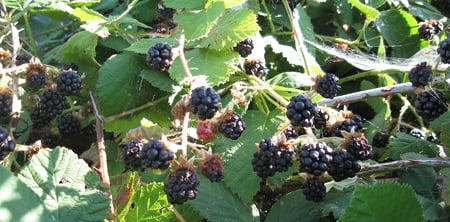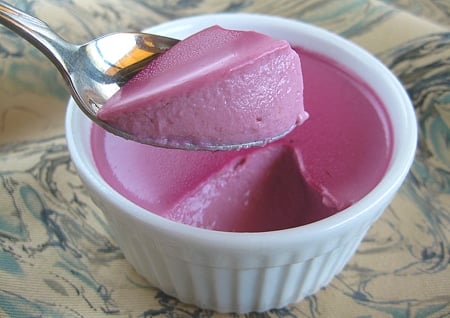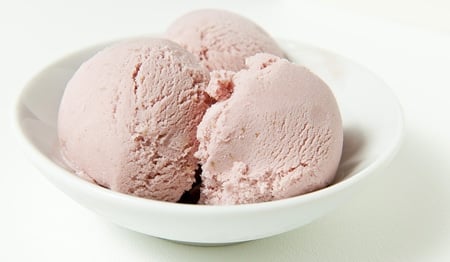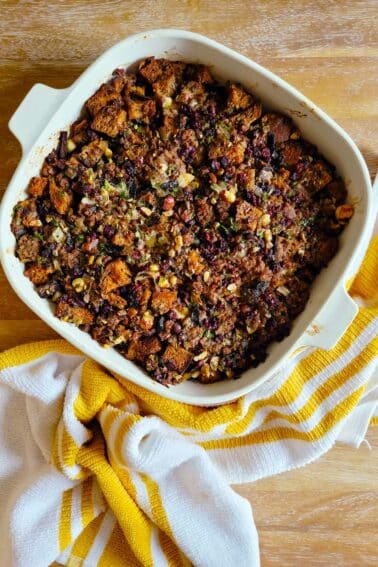As an Amazon Associate I earn from qualifying purchases.

I’ve been on a berry rampage this month. Since August 1, I have foraged for nine — count ’em, nine — different varieties of wild berries within 150 miles of my house. That variety surprised even me; I literally stumbled upon several of the varieties, some of which I’d never even seen before.
Foraging led to cooking, of course, and I’ve posted roughly a dozen new berry-related recipes in the past month, and have done all sorts of bizarre experiments with some of the weirder fruit I’ve found; some of you read about my manzanita cider last week.
When I was done, I realized that to write one post on all I’ve learned would be madness — it’d take something like 5,000 words (yeah, I know, I can be long-winded. Sue me), which few of you have time to read. So I’ve broken my berry extravaganza into three pieces: Berries of the Central Valley, where I live; berries of the High Sierra; and berries of the Coastal Range.
Don’t live in California? Rest assured you can still read on — almost all of these berries also live in other Western states, and most have variants in the East, like the blackberries and elderberries I’m writing about today.
Are there other wild berries in the Central Valley? You bet. But with one exception, elderberries and blackberries are the most common, the tastiest and the easiest to find in quantity; the exception is the wild grape, and I’ll get to that one in September.
BLACKBERRIES
Might as well start with the one fruit pretty much every American can spot from a distance, the humble blackberry.

Blackberries grow everywhere here. They are invasive, full of thorns, and are oh-so tasty if you can beat the birds to them. So far as I know, blackberries can be found in every state, and they all come ripe between June and September, depending on where you are. The various species are all interchangeable in recipes.
The plants are easy to recognize: Blackberries grow as brier patches made up of thorny canes. They have white flowers in spring and the berries ripen from green to red to black. And, um, ahem, know that the blackberry is NOT a raspberry, which has red fruit. I have a vivid memory of my sister telling me to try that “red blackberry” once when I was a kid. It was so sour I almost cried. I am still plotting revenge on her for that one, all these years later…
A ripe blackberry pulls off the bush easily. They are very soft, however, so collect them in shallow, broad baskets so you don’t pile them too high. Doing so will smush the berries. You will undoubtedly pick lots of slightly less ripe berries, and this is a good thing — it balances the acid and sugar when you are making things with them.
Blackberries have excellent amounts of sugar and acid, but low tannins, which matters much only if you are making wine. Most people store whole berries by freezing them on sheet pans in one layer to prevent sticking, then putting the frozen berries in a sealable bag. I cook them down and make a blackberry syrup instead.
What do you do with blackberry syrup? Well, it’s pretty awesome on pancakes or vanilla ice cream; I served some over an ice cream flavored with yerba buena the other day. (Yerba buena is a kind of mint that grows all over Southern California.)
Another obvious one is blackberry liqueur. How easy is this? Wash dust off blackberries, fill a quart Mason jar two-thirds full and fill to the rim with 100-proof vodka. Let this steep in the pantry for anywhere from a month to a year, strain and sweeten to taste. Easy-peasy.
Getting a little sportier, I decided to make a blackberry panna cotta. Most blackberry panna cotta recipes are really vanilla panna cotta with a blackberry compote; I did something like this earlier this year with a lemon verbena panna cotta and a mulberry compote. This time I wanted the blackberries in the cream.

Ooh yeah, baby! I’ve been tinkering with the amount of gelatin in my panna cotta experiments (What? You don’t do panna cotta experiments, too?) and I finally nailed it with this one. A good panna cotta should just barely hold itself together, and be so rich and creamy you can’t eat more than a little ramekin full. Score that on this one.
Other things to do with blackberries? There are scores of recipes beyond the panna cotta, liqueur and syrup, but I like these best:
- My friend Elise’s blackberry pie
- Heidi Swanson’s blackberry limeade
- And my other friend Jaden Hair’s Salmon with Blackberry Brandy Sauce. I know, it sounds nasty and weird. It isn’t. It really works, and the sauce is actually better with venison.
ELDERBERRIES
The other main summertime fruit around these parts is the elderberry, sambucus cerulea. I’ve written about elderberries before, but there is always more to tell.
First off, let me say that while I can eat lots of ripe elderberries right off the bush, not everyone can. Some people get nauseous if they eat too many raw ones. Cooked, however, anyone can enjoy them, and elderberry syrup is considered a medicinal tonic in many countries; you can buy it at health food stores all over America.
Elderberries grow on large bushes that can occasionally become small trees. The buttercream-colored flowers are on clusters, and the berries ripen from green to almost black. In full sun, the Western elderberry will often develop a frosty bloom like a winegrape. Eastern elderberries rarely get this bloom.

Collect the berries by cutting whole clusters, which can weigh more than a pound each. You know you want to pick them when they are a) all black or frosty, and b) the stem is reddish. You can pick ripe clusters when the stem is green, but the berries won’t come off the stems as easily.
And you must get the elderberries off the stems: Every other part of the plant is toxic. Can you have a couple stems that slip by? Sure, no biggie. But do your best to get them all.
Elderberries have plenty of acid, good tannins, but not a ton of sugar. They are a deep purple when juiced and have an aroma almost exactly like red winegrapes — think of the bouquet on the fruitiest Zinfandel you’ve ever smelled and that’s close. I am sad to say that the Eastern elderberry lacks this wonderful aroma; it’s why Westerners don’t really understand that Monty Python joke about your father “smelling of elderberries.”
The berries are seedy, too, so elderberry jam is not ideal, although it will most definitely keep you regular. So what do you do with elderberries?
- Make elderberry liqueur
- Make the mysterious pontack, a British vinegary elderberry sauce said to be best after it’s aged more than seven years
- Elise at Simply Recipes makes elderberry jelly
- Use the jelly for a classic Cumberland Sauce with wild game
- Another friend, David Lebovitz, has a good recipe for elderberry syrup
- Make the syrup and use it for an elderberry ice cream
- Or, if you are really adventurous, make your own elderberry wine
Now I am not putting down the recipe for my elderberry wine because it is complicated and you need to have some idea about making wine to start with. Oh, and there is another reason: I include step-by-step instructions on how to do it in my upcoming book, which should be out in spring 2011. I know, I know, teasing is mean…
Tide yourself over with this elderberry ice cream, which has some creme fraiche and elderberry liqueur tossed in to make it just that much better. It’s damn good: Tangy and rich, smooth and fruity.

Incidentally, elderberry season is pretty much over here in the Valley, but it is just starting in the Sierra, and in the rest of the country.
UP NEXT: Berries in the High Sierra — duds, diamonds and deliciousness



